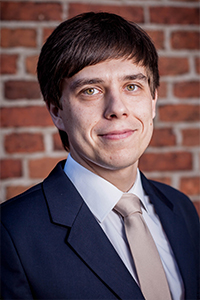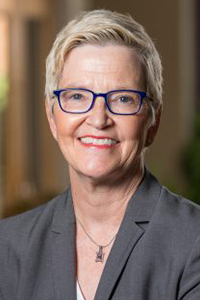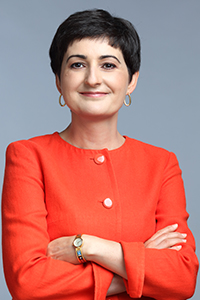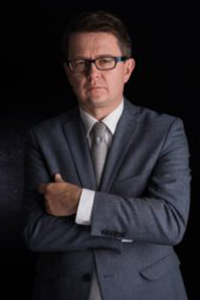SPEAKERS
TRADE SECRETS IN THEORY AND PRACTICE
International IP Conference
17 October 2019, Warsaw
 Christoph Ann, Technical University of Munich BIO BIO Christoph Ann has been full professor of law (ordinarius) and holder of the Technical University of Munich’s Chair of Corporate and Intellectual Property Law, the German speaking world’s oldest and largest chair for patent law. His academic focus are patents trade secrets including licensing and competition law and their respective business environments (IP strategy and IP management). Professor Ann earned law degrees in both, Germany and the U.S. (LL.M., Duke ’88). Before obtaining his present chair at the Technical University of Munich, he practiced corporate law as an attorney in Munich and Erlangen, and from 2000-2003 taught IP law as a full Professor of Law at Freiburg University’s Faculty of Law, then Germany’s #1 law school. Christoph Ann often teaches abroad and has done so at universities in Australia, France, Hungary, Japan, and the U.S. He is an adjunct professor at GWU Law School (Washington D.C.) and at La Trobe Univ, School of Law (Melbourne), and currently serves as Distinguished Guest Professor (Global) at Keio Univ., Graduate School of Law (Tokyo). ABSTRACT ABSTRACT Trade secrets protection – why protect, how and by whom? Introduction into trade secrets law The presentation will concern:
|
 Tanya Aplin, Dickson Poon School of Law, King’s College London BIO BIO Tanya Aplin is a Professor of Intellectual Property Law at the Dickson Poon School of Law, King’s College London. She is also Vice-Dean for Research in the Law School, Director of the Postgraduate Diploma in UK, EU and US Copyright Law and Director of the LLM in Intellectual Property and Information Law. Her publications include: Copyright law in the digital society: the challenges of multimedia (Hart, 2005), Intellectual Property: Patents, Copyright, Trade Marks and Allied Rights 7th, 8th and 9th eds (Sweet & Maxwell, 2010, 2013, 2019) (with Prof. Cornish and Prof. Llewelyn), Intellectual Property Law: Text, Cases and Materials 1st, 2nd and 3rd eds (OUP, 2009, 2013, 2016) (with Dr Davis), and Gurry on Breach of Confidence: The Protection of Confidential Information (OUP, 2012) (with Prof. Bently, Dr Johnson and Mr Malynicz). She teaches courses on comparative copyright law and EU and UK patent and trade secrets law. ABSTRACT ABSTRACT The limits of EU trade secret protection Trade secrets protection has been harmonised in the EU by the Trade Secrets Directive 2016/943. The Directive indicates that trade secrets protection is a complement or alternative to intellectual property rights and the Directive is not seeking to create exclusive rights (see recitals 2 and 16). But the legal mechanism for protecting trade secrets is otherwise left ambiguous, although the provisions of the Directive suggest, if anything, an unfair competition type approach. This ambiguity in the legal means of protection is also reflected in Articles 3 and 5, which refer to acts of lawful acts of acquisition, use and disclosure and situations in which there would be a disentitlement to remedies in the cases of certain alleged acts of acquisition, use or disclosure. In other words, there are no explicit exceptions or limitations to trade secrets protection in the sense that we would normally see for intellectual property rights. This structural point poses questions for both implementation and interpretation of Articles 3 and 5. In addition, there are specific questions that arise in the instances of independent creation, reverse engineering and other honest commercial practices, and when exercising the right to freedom of expression or revealing misconduct/ wrongdoing in the public interest. As a result, we are likely to see divergent applications of Articles 3 and 5, which cuts against the harmonisation objective of the Directive. |
 Arpan Banerjee, UNSW, Sydney; Jindal Law School, India. BIO BIO Arpan Banerjee is a Scientia Doctoral Scholar at the University of New South Wales in Australia. He is on leave from Jindal Global Law School in India, where he serves as Assistant Professor and Director of the Centre for IP & Technology Law. Arpan has published widely and received various grants and awards. In recent years, his accomplishments and engagements include being awarded the Alexander von Humboldt Foundation German Chancellor Fellowship, being co-awarded the British Academy Leverhulme Small Research Grant, being selected for the Stanford Law School-University of Pennsylvania International Junior Faculty Forum, and winning the ATRIP writing prize for young scholars. ABSTRACT ABSTRACT Business Process Outsourcing and the Protection of Trade Secrets in India The size of the global BPO and KPO industry is estimated at USD 150 billion, of which India’s share is estimated at around 65 percent. However, India has not enacted specific trade secrets legislation. Overseas entities are thus mostly reliant on the law of contracts and breach of confidence. The absence of trade secrets legislation in India has been a source of friction with the US and EU (with whom India is currently negotiating a free trade agreement). It is arguable that India’s reluctance to enact a trade secrets law stems from a traditionally ambivalent attitude towards the expansion of its IP regime. This paper will provide an overview of Indian case law on contracts and breach of confidence. It will argue that such case law will show that the enactment of a trade secrets law will not be a major disruptor to the status quo, and will also provide greater clarity. Furthermore, amidst growing pressure by trade protectionists overseas to curb outsourcing to India, enacting a trade secrets law may also serve a useful political purpose. The paper will then discuss the possible contours of an Indian trade secrets law, amidst possibly conflicting demands from different lobby groups and demands by the US/EU to model the legislation as closely to their laws as possible. |
 Wojciech Biernacki BIO BIO Wojciech Biernacki is a graduate in law at the Adam Mickiewicz University in Poznań. He studied previously at the University of Ferrara, Italy, within the Erasmus+ scholarship. His professional experience includes working in Italian and Polish law firms operating in intellectual property. He is an Individual Observer in the European Law Institute in Vienna, Austria, and member of the Digital Law Special Interest Group said Institute. Currently, he is associated with a copyright attorney office. His academic interests include protection of non-personal data, modern challenges of copyright, and legal issues of Industry 4.0. He is based in Poznań, Poland. ABSTRACT ABSTRACT Applicability of the EU trade secret protection to sensor data The potential of data for the modern economy derives from the possibility of their use within the so-called data value chain. This variation of the Porter’s chain provides that a certain set of data may be useful for different parties that process it for various purposes. One of the types of data, paradigmatic for the data-driven economy, is sensor data, also called data from nature, containing information about certain measurable features of reality – e.g. ambient temperature, traffic at an intersection. These data, which are generally the carrier of simple, “meaningless” information, show significant value when aggregated and placed in a context, eventually being a source of economically useful knowledge. They are generated 1) using the manufacturer’s technology; 2) through the activity of the user of the item equipped with sensors; and 3) they prove to be useful for the third parties not involved in the process of their production. Observation of this practice leads to this question: can a set of sensor data (e.g. the traffic situation around a moving vehicle) be subject to the trade secret protection within the meaning of the Directive 2016/943? The observation raises a number of doubts referring to: 1) the conformity with the object of trade secret protection and 2) fulfillment of the grounds for trade secret protection. The first of the issues refers basically to the object of the trade secret protection. The EU legislator uses the term “information” covering only the semantic level on which information exists (according to Zech’s typology). At the same time, it does not cover the way information is expressed (fixed). Second, it is necessary to consider the condition of secrecy. Data from sensors represent a state of nature that is perceivable by any observer present at the scene. However, a particular way in which state of reality is fixed – i.e. binary code – is an already processed form thereof and therefore not generally available. A third issue is related to the possibility of keeping data secret: in a situation when, within the business cycle, the data are transferred to remote processors, ensuring their confidentiality may lack feasibility. These considerations focus on a practical situation, such as applicability of trade secret protection in the mentioned three-way relation that includes the manufacturer of the data collecting equipment, the user of data collecting devices, and the third party receiving data for further processing. |
 Martin Husovec, University of Tilburg BIO BIO Martin is an Assistant Professor at the Tilburg University, the Netherlands, appointed jointly by Tilburg Institute for Law, Technology and Society (TILT) and Tilburg Law and Economics Center (TILEC), and an Affiliated Scholar at Center for Internet and Society (CIS) of Stanford Law School. His scholarship focuses on innovation and digital liberties, in particular, regulation of intellectual property and freedom of expression. Martin obtained his Ph.D. from the Max Planck Institute for Innovation and Competition and Ludwig Maximilian University in Munich for his work on injunctions against intermediaries (published with Cambridge University Press, 2017). He was a visiting researcher at Stanford Law School (2014), Japanese Institute for Intellectual Property (2015), the Central European University (2018) and the European University Institute (2018). ABSTRACT ABSTRACT ‘(Un)Fair Remedies in Trade Secrecy Law’ The trade secrecy law and intellectual property law have a separate set of rules for remedies and enforcement in the EU law. This talk will explore how interrelated are these two bodies of rules, what can they learn from each other and how their parallel and/or synchronized application can develop in the CJEU case-law in the coming years. Particular emphasis will be put on the limitations and flexibilities inherent to these two sets of remedies. |
 Magdalena Kolasa BIO BIO Dr. Magdalena Kolasa, LL.M. (IP) specialises in the law of intellectual property. Having worked for several years in private practice she conducted her doctoral research in the area of trade secrets at the Max Planck Institute for Innovation and Competition in Munich, Germany. Since 2013 she works as lawyer in the European Patent Office. ABSTRACT ABSTRACT “Cocktails on the rocks. The challenges of enforcing trade secrets against departed employees from a comparative perspective” Due to their perishable nature, trade secrets have been compared to an ice cube: the information is valuable as long as it remains secret. Employees have access to their employer’s confidential information and create further valuable data during their employment time. It is mixed and stirred with publicly accessible information and the employees’ skills and expertise. As a result, employees and former employees are one of the greatest threats to corporate secrecy. Enforcement of trade secrets against former employees poses particular challenges, as it may encroach upon their right to choose an occupation and exercise a professional activity. The pitfalls in enforcement of trade secrets in a post-employment scenario include determining the protected information, the scope of post-employment duties and enforceability of any contractual regulation of these duties. A comparative analysis of UK, German and US law shows that the guiding principles in this context are proportionality, fairness and balancing of interests, principles reflected in the Trade Secrets Directive of 2016. While one size does not fit all, some rules of thumb based on these principles can be identified and applied in the context of protection of trade secrets in a post-employment scenario. |
 Konrad Mazur, Adam Mickiewicz University of Poznan BIO BIO Konrad M. Mazur is a PhD candidate at the Faculty of Law (European Law Chair) at Adam Mickiewicz University in Poznań. He is preparing a doctoral dissertation on the protection of trade secrets and employee mobility. His scientific interests are focused on legal aspects of information protection in the ICT sector – trade secrets, personal data and intellectual property & cybersecurity topics. Konrad is also an of counsel lawyer at a boutique attorney at law company. ABSTRACT ABSTRACT The majority of trade secret cases appear nowadays in disputes related to the employment relationship. Employers must share trade secrets with their employees to be able to take advantage of their expertise on the market. But what to do when an employee leaves work and all trade secrets that he knows, still remain in his head? How to coherently protect trade secrets while sharing them with employees and anticipating that some of them may be employed by competitors because of their unique knowledge? Progress in technology development, growing knowledge-based economy and the ease of changing jobs increases this problem. It is increasingly difficult to say where is the boundary between a trade secret and knowledge honestly acquired by the employee during his employment period. |
 Anna Popowicz- Pazdej, University of Wrocław BIO BIO Anna Popowicz – Pazdej – attorney at law, a Ph.D. student at the University of Wroclaw, Faculty of Law, Administration and Economy in the course of writing dissertation on public procurement law and personal data protection. Currently focused on issues regarding trade secrets and personal data protection within public procurement procedures. ABSTRACT ABSTRACT Protecting trade secrets as an exception to the general transparency rule in public procurement law from a European and national law perspective. One of the main principles of public procurement law is ensuring the procedure for awarding public contracts is transparent. This not only guarantees that the procedure is transparent, but there is also a right of access to documents as well as the right to fair and undistorted competition for the procurement of public contracts. Another exception to the general transparency rule apart from protecting personal data, is to protect information that constitutes a trade secret (art. 8.3. Polish public procurement law). The exception here occurs when the bidder specifies in their offer that access to certain categories of information related to their procurement shall be restricted because it is a trade secret and can prove that the information actually constitutes a trade secret. The definition of a trade secret in Polish public procurement law is determined by Art. 11(4) within the act on Combating Unfair Competition, 16 April 1993 (CUC Act). This has been amended recently in order to implement the Trade Secret Directive 2016/943 (Directive). Although, at the European level, the Directive does not specifically regulate trade secret protection within public procurement. It simply affects public procurement by requiring Member States to harmonise the concept and provide a definition of a trade secret. It is expressly stated within the Directive (recital 14 and art. 1 (2b) and (2c) that the Directive shall not affect the application of union or national rules that requires the information disclosure, including trade secrets, to public bodies. Therefore, it is understood that during assessment, if the trade secret really exists, public bodies also have to provide specific reasoning based on the rules derived from the Directive. Whereas in Poland, public bodies are generally obliged to make an assessment only if the particular information the bidder is proposing to reserve constitutes a trade secret in the meaning of art. 11(4) of the CUC Act. This could potentially mean that Poland may have implemented the Directive incorrectly. In order to resolve this issue, an analysis should be carried out, on the one hand based on Directive 2014/24/EU on public procurement and on the other hand, on the concept of trade secrets. It has to, undoubtedly, be taken into consideration that the disclosure of a trade secret in some cases not only could damage a particular business’s trade, but may also cast a dark shadow on the public procurement regime itself. |
 Sharon Sandeen, Mitchell Hamline School of Law, USA BIO BIO Professor Sharon K. Sandeen is director of the IP Institute at Mitchell Hamline and an internationally recognized expert on trade secret law, having written three books (with E. Rowe) and more than 25 articles and book chapters on trade secret law and other intellectual property topics, including the first casebook on trade secret law in the United States (Cases and Materials in Trade Secret Law), a book on international trade secret protection (Trade Secrecy and International Transactions), and detailed examinations of the drafting histories of the Uniform Trade Secrets Act and Article 39 of the TRIPS Agreement. She is also the editor of the IP Deskbook for Business Lawyers, now in its third edition. Since 1996, Professor Sandeen has taught an IP survey course at least once a year as well as a variety of other IP courses, including Trademark Law, Copyright Law, Computer & Internet Law, Trade Secret Law, and International Intellectual Property Law. Prior to becoming a professor, she practiced law for more than 15 years in Sacramento, California, first as a general business and IP litigator at the largest law firm in Sacramento and later as an intellectual property specialist at a boutique firm. ABSTRACT ABSTRACT Mapping Trade Secret Scholarship: The Past, Present, and Future In 2006, I wrote a chapter for a book on intellectual property (IP) titled The Cinderella of Intellectual Property Law: Trade Secrets (in INTELLECTUAL PROPERTY AND INFORMATION WEALTH: ISSUES AND PRACTICES IN THE DIGITAL AGE, Peter K. Yu ed.) in which I lamented the lack of attention to trade secret law. This work was intended to spark conversation and scholarship about trade secret law both in the United States and internationally. A key point that I made was that trade secrets are not new. In fact, judging from case decisions dating from the 19th century in the United States, businesses have long relied on principles of trade secrecy to protect information that they deem important and competitively significant. However, for much of the history of trade secret law, trade secret principles had not been the subject of much scholarship in the legal academy, particularly as compared to the IP “princesses” of patent, copyright, and trademark law. A lot has happened since 2006 concerning trade secret law, but the pace of trade secret scholarship is still relatively slow. With the recent adoption in the United States of the Defend Trade Secrets Act of 2016 and the 2016 adoption of the EU Trade Secret Directive, however, it now appears that more scholars are paying attention to trade secret law, particularly in Europe. This is a positive development because, although trade secret law (at least in the United States) dates back more than 150 years, there are still numerous issues in need of exploration. Some of these issues are highlighted in the language of the DTSA and the EU Trade Secret Directive while others concern ancillary principles of law that, among other things, limit the scope of trade secret protection. The purpose of my presentation is to provide an overview of trade secret scholarship through the present day and to identify those issues upon which more trade secret scholarship is needed in the future. |
 Peter Slowinski, Max Planck Institute for Innovation and Competition, Munich BIO BIO Peter R. Slowinski is a Junior Research Fellow at the Max Planck Institute for Innovation and Competition in Munich. He is admitted as attorney-at-law (Rechtsanwalt) in Germany as well as a qualified and certified mediator. His research focuses on patents and dispute resolution. He has published on copyright law and patent law. His doctoral research concerns the appropriate balance in the enforcement of IPRs. Peter Slowinski has conducted an empirical study on mediation proceedings in patent law at Stanford Law School and participated in the SPC Study of the Max Planck Institute for Innovation and Competition. He is a member of the research groups on data driven economies and artificial intelligence as well as life sciences at the Max Planck Institute. ABSTRACT ABSTRACT Trade Secrets in Judicial and Mediation Procedures – The tension between openness and secrecy Depending on the business model and the specific industry, trade secrets can be more important for a company’s success than patents or copyright. While keeping vital information secret and protecting it from illegitimate appropriation is one side of the coin, the actual enforcement of the rights of a trade secret holder in cases of actual infringement is the other side. Here the right holder and the judicial system are faced with one problem that stems from the very nature of judicial proceedings particularly in the European Union but also in other jurisdictions such as the USA: judicial proceedings are conducted in open court with the general public having access at least to the proceedings if not to the documents filed with the court. So if the trade secret holder wishes to enforce his rights, he needs to explain in (open) court, what this secrets are, at which point the secrets are no longer secret. To protect their trade secrets, right holders may therefore turn to alternative dispute resolution mechanisms such as arbitration and particularly mediation. One of the advantages of mediation that is usually brought forward in comparison to court proceedings is the confidential nature of the process. What is being said in mediation or submitted in writing during the proceeding, is confidential and cannot be used outside of the process. But here again the question arises, how violations of the confidentiality can be pursued. After all, if the confidentiality cannot be enforced, parties must fear that all information shared in a mediation may be misappropriated and will thus be less willing to share information, putting the whole process in jeopardy. My article and presentation take a look at court proceedings and common mediation guidelines to establish how exactly trade secrets are protected in the two dispute resolution processes. It highlights deficits and proposes some changes to ensure the functioning of the systems while preserving their traditional core elements. |
 Juan Antonio Vives-Vallés, University of Balearic Islands BIO BIO Trained in Agricultura Engineering, Plant Sciences and Law, he is specialized in IP in Agriculture and Plant Innovation, with a strong focus on Plant Variety Rights. He was doing research at the Max-Planck-Institute for Innovation and Competition in Munich since June 2016 to September 2018 while carrying out an LL.M. in Intellectual Property and Competition Law, thanks to several scholarships granted by the Institute. Profesor contratado doctor at the University of the Balearic Islands, he is currently doing research at the CPVO in Angers. ABSTRACT ABSTRACT Trade Secrets and Protected Variety Rights In comparison to cross-pollinated plant varieties, hybrid plant varieties usually offer higher yields and uniformity, as well as the additional incentive for breeders of extra protection against unwanted reproductions.1 Besides, the disclosure of the parent lines used in the generation of a hybrid plant variety is not required under the UPOV Convention, what results in a ‘secret-type protection’ of hybrid varieties.2 These characteristics of hybrid protected plant varieties among other reasons has led some scholars to vehemently oppose hybrids.3 This paper analyses the rationale of the possibility of secrecy or non-disclosure of the parent lines of protected plant varieties under both the UPOV Convention and the Council Regulation (EC) No 2100/94 of 27 July 1994 on Community plant variety rights. It also explores the implications of the EU norms about Trade Secrets, transparency and public access on the secrecy of this kind of information and on the activity of Intellectual Property Offices dealing with plant varieties in the EU. The feasibility in practice of several (de lege ferenda) regulatory scenarios and its potential implications in the activity of Intellectual Property Offices and plant breeding is also assessed. |
 Laura Zoboli, Faculty of Management, University of Warsaw BIO BIO Laura Zoboli is Assistant Professor of European Economic Law at the University of Warsaw and permanent member of the Centre for Antitrust and Regulatory Studies. Before joining the University of Warsaw, she obtained her PhD in International Law and Economics at Bocconi University, where she teaches in the fields of Intellectual Property and European Union Law. Laura also clerked in the Competition and IP Specialized Court in Milan and was a visiting researcher at the Max Planck Institute for Innovation and Competition and at the Berkman Klein Center in Harvard. Her current research interests focus on the overlaps between IP and Competition Law within digital markets and specifically on data economy. ABSTRACT ABSTRACT Algorithms: balancing trade secrecy and transparency Usually, algorithms are secret; they have value because secret and – therefore – they are subjects to measures meant to keep them confidential. In other words, the economic value of algorithms is often nullified by their disclosure. In this context, it is relevant to remember that algorithms fall within the scope of the Trade Secret Directive (Art. 2): they can be protected as trade secrets. Nonetheless, the lack of transparency of algorithms can – at certain conditions – raise issues, not making possible the assessment of algorithms fairness and not consenting the detection of unlawful behaviours via algorithms. Thus, at certain conditions, algorithms transparency should be allowed. The Trade Secrets Directive does not impose any form of algorithmic transparency. In other words, the Directive itself does not balance the interest of protecting algorithms as trade secrets and of imposing the algorithmic transparency, when needed. However, the Directive recognizes the existence of cases in which the commercial interests can give way to the protection of other values. Therefore, the basis for the algorithmic transparency should be found outside the Trade Secrets Directive – within further EU or national laws. In the presence of such a law granting a form on algorithmic transparency, the Trade Secret Directive could not be invoked to protect the secrecy of algorithms. The research will then look for national laws considering algorithmic transparency and – therefore – limiting the protection of algorithms as trade secrets. |
 Lavinia Brancusi, Institute of Law Studies, Polish Academy of Sciences BIO BIO Dr. Lavinia Brancusi (Brâncuși) an adiunkt at New Technologies Law Centre, Institute of Law Studies, Polish Academy of Sciences in Warsaw. She held her law degrees at Warsaw University, Faculty of Law (master, dr. iur.) with an awarded doctoral dissertation in design law. Previously she hold an academic position at Cardinal Stefan Wyszynski University in Warsaw with lectures in the field of Polish civil law, industrial property and unfair competition. She is also an of counsel at AOMB Intellectual Property in Warsaw. Her research interests cover cumulative protection in intellectual property, with a specific focus on product protection, functionality in trademark and design law as well as the interface between IP and competition rules, especially in relation to brands. More about her publications and presentations on www.laviniabrancusi.edu.pl |
 Żaneta Pacud, Institute of Law Studies, Polish Academy of Sciences BIO BIO Dr Żaneta Pacud is an Assistant Professor in the Institute of Law Studies at the Polish Academy of Sciences in Warsaw. She graduated in law and European studies at Adam Mickiewicz University in Poznan and in 2012 she obtained her PhD at the Jagiellonian University in Cracow. For her dissertation, devoted to patent protection of medicinal products, she was awarded by Ministry of Science and Higher Education in the contest for the best doctoral thesis in the field of intellectual property. Her interests focus on industrial property, especially in the area of life science. She authored numerous publications and presented extensively within this field. She also gained experience in international research projects (e.g. Innovation expert system, IP in agriculture) and cooperated as an external expert with the Polish Patent Office and WIPO. In 2017 and 2018 she held scholarships at the Max Planck Institute for Innovation and Competition. Currently she conducts her studies on regulatory exclusivities and on biotechnological inventions in the context of fundamental rights. |
 Rafał Sikorski, Adam Mickiewicz University of Poznań BIO BIO Rafał Sikorski is a Professor of Law at the Faculty of Law of the Adam Mickiewicz University in Poznań, Poland. He teaches intellectual property, civil, private international and European Union law. In 2000 he obtained an LL.M. in International Business Transactions from the Central European University in Budapest, Hungary. In 2005 he obtained his Ph.D. from the Adam Mickiewicz University. His major research areas include: patent law, patent remedies, intersection of intellectual property and competition law, standardization and standard essential patents, as well as private ordering in patent law. He has published on patent pools, SEPs and standard-setting, patent remedies, conflicts-of-law rules for IP contracts and IP infringement as well as on copyright law. Professor Sikorski is also an attorney-at-law and a senior partner at SMM Legal, one of the leading Polish law firms. At SMM Legal he heads the IP Department. |
 Anna Tischner, Jagiellonian University BIO BIO Anna Tischner (dr hab.) is Professor of Law at the Faculty of Law (Intellectual Property Law Chair) of the Jagiellonian University in Cracow, Poland. Anna’s main field of academic interest is: industrial property and unfair competition law. She is especially interested in European design and trade mark law. Her publications include two monographs (in Polish): “Civil liability for trade mark infringement” (WoltersKluwer 2008) and “Cumulative protection of designs in the intellectual property law” (C.H. Beck 2015), numerous chapters, articles and selected parts of a commentary on the Polish Industrial Property Act (Beck 2014). She is also the co-editor of the Jagiellonian University Intellectual Property Law Review, peer-reviewer of the International Journal of Intellectual Property and Competition Law (IIC). Anna has been a member of ATRIP since 2009 and ATRIP ExCo member for the term 2016-2020. She is also a member of the External Advisory Board of EIPIN Innovation Society programme. Since 2017 Anna is Director of the Krakow IP Law Summer School. |
 Łukasz Żelechowski, University of Warsaw BIO BIO Łukasz Żelechowski is Assistant Professor at the University of Warsaw, Faculty of Law and Administration, Department of Intellectual Property Law. He is also Of Counsel at LDS Łazewski Depo i Wspólnicy, Warsaw, and Arbitrator at the Arbitration Court for Domain Names at the Polish Chamber of Information Technology and Telecommunications. He is qualified Polish patent attorney. He was scholarship holder at the Max-Planck-Institute for Innovation and Competition in Munich (2007) and guest lecturer at the University of Ottawa, Faculty of Law (2012, lectures on International Industrial Property Law). |